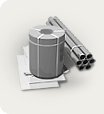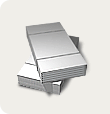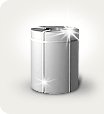Overview of popular materials used for wall and facade insulation
Effective insulation of walls and facades is an important aspect of creating energy-efficient and comfortable conditions in buildings. Choosing the right insulation materials plays a key role in achieving optimal results. In this article, we will look at the popular materials used for wall and facade insulation and their main characteristics.
-
Mineral wool:
- Description: Mineral wool is a thermal insulation material made from basalt rock or fiberglass.
- Benefits:
- High thermal insulation: Mineral wool has a low coefficient of thermal conductivity, which allows you to effectively store heat inside the building.
- Hydrophobicity: The material does not absorb moisture and retains its thermal insulation properties even when exposed to moisture.
- Fire resistance: Mineral wool is a fire resistant material, which ensures the safety of the building.
- Application: Mineral wool is widely used to insulate walls and facades of various types of buildings.
-
Polyfoam:
- Description: Styrofoam is expanded polystyrene, a lightweight and durable material obtained from polystyrene with the addition of foam.
- Benefits:
- Easy and easy to install: Styrofoam is lightweight and easy to process, which facilitates the process of insulating walls and facades.
- Insulation: Styrofoam has a low coefficient of thermal conductivity, which allows you to effectively store heat inside the building.
- Moisture resistance: The foam does not absorb moisture and retains its thermal insulation properties even when exposed to moisture.
Comparative analysis of the properties and advantages of various heaters
The right choice of insulation is a key factor in insulating the walls and facades of a building. Each material has its own characteristics and advantages that must be considered when making a decision. In this article, we will compare the properties and benefits of various insulation materials to help you make an informed choice.
-
Mineral wool:
- Insulation: Mineral wool has high thermal insulation due to its low thermal conductivity.
- Soundproofing: Mineral wool also has good soundproofing properties, which helps to reduce indoor noise pollution.
- Moisture resistance: Mineral wool does not absorb moisture and retains its thermal insulation properties even when exposed to moisture.
- Fire resistance: Mineral wool is a fire resistant material, which ensures the safety of the building.
-
Polyfoam:
- Easy and easy to install: The foam is lightweight and easy to handle, which simplifies the process of insulating walls and facades.
- Heat insulation: Styrofoam has good thermal insulation properties and is able to reduce heat loss through the walls and facades of the building.
- Moisture resistance: The foam does not absorb moisture and maintains its thermal insulation efficiency even when exposed to moisture.
- Cost-effective: Styrofoam is a relatively inexpensive material, which makes it attractive from an economic point of view.
-
Extruded polystyrene foam:
- Strength and resistance: Extruded polystyrene foam has high strength and resistance to various factors
Recommendations for choosing the most suitable material depending on the operating conditions and the required energy efficiency
The choice of a suitable material for the insulation of walls and facades is a key step in the process of building insulation. When choosing a material, it is necessary to take into account various factors, such as operating conditions, climatic features of the region and the required energy efficiency. In this article, we will present recommendations for choosing the most suitable material depending on the operating conditions and the required energy efficiency.
-
Terms of use:
- Climatic conditions: Consider the climatic features of the region in which the building is located. Some materials may be more suitable for cold climates, while other materials may be a better choice for warm climates.
- Intensity of use: If the building is subject to heavy use or is located in an area with high humidity, it is necessary to choose a material that has increased resistance to moisture and wear.
-
Required energy efficiency:
- Coefficient of heat






